Oyster farms in Deep Bay, BC
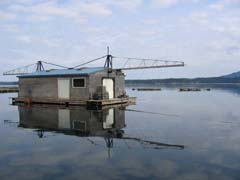
On April 31 and May 1, 2005 , we visited two oyster growers on Vancouver Island at Deep Bay , north of Nanaimo . Both were recommended by Blue Revolution's Brian Kingzett; Brian has farmed on the outside coast of Vancouver Island and is currently a consultant whom many of you met at the Aquaculture Conference in the fall of 2004. Brian recommended these two particular farmers because they represent essentially opposite ends of the oyster business in B.C..
Our interest in learning more about the methodology used by these growers grew from discussions during the conference regarding the use of trays instead of nets: because we purchased an already functioning farm, we have a significant financial investment in our farm but are still on the early end of investment in equipment like boat, nets, etc. We decided that it would be smart to learn as much as possible about various methods of culture prior to making further investments - and we did learn a lot! We want to share what we learned with you. The following notes are a compilation of our combined recollections.
First, some general observations about the B.C. oyster business:
- They appear to have a great deal of support from the provincial government in terms of support for the industry - research, educational programs, etc.
- Most of the farming is done from rafts, although there are still a few farmers using long lines. The raft approach permits denser and more efficient use of any given acreage. Our understanding is that the long line growers tend to grow large oysters primarily for what was referred to as the "meat" market - that part of the industry that shucks and cans the oysters. They have approximately half the tidal surge we do on Kachemak Bay , but they do get five-foot seas upon occasion. They sometimes get 1-2 inches of ice that forms in the wintertime.
- It also appears that virtually everyone down there uses trays instead of nets, and that there are three basic variations on the tray systems: fairly deep "high flow" stackable plastic trays designed and produced by Keith Reid of Stellar Bay Shellfish; less deep plastic stackable trays made by Dark Seas; and stackable polymer covered wire trays made by Aqua-Pacific.
- Both farmers said the best seed they have ever found is from Kuiper Mariculture of Eureka California (Ted and Linda Kuiper, 707-822-9057 - he is apparently often referred to as "the sultan of seed"!).
Farmer #1 : Tom Plensky (young partner is named Ron Osmond) is a genial and gracious man who has fished all over the world, and has been oyster farming at Deep Bay for many years. He has sold most of his acreage to Keith Reid aka Farmer #2!
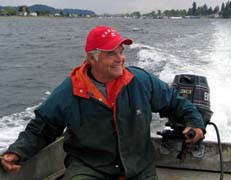 Tom Plensky
Tom Plensky
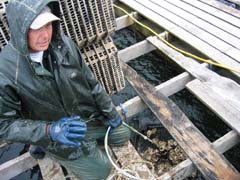 Ron Osmond
Ron Osmond
- Tom has one raft and Ron has another. The rafts are 24' wide and 70' long they hang 8 stacks of trays across the width of the raft; alternating depth in every direction in order to avoid tangling, and some of his trays are very deep (he is experimenting to see if there may be fewer barnacle sets on the deeper trays…).
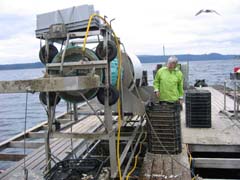 Tom's raft and tumbler
Tom's raft and tumbler 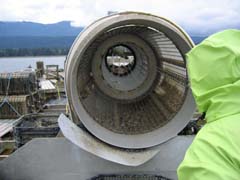
- Tom has a tumbler on the raft and it is set up so that he can manage it all alone: he dumps two trays of oysters in at the top, lets them tumble and roll down to the bottom where he spreads them into trays to put back in the water.
- His boat has a boom on it which can lift the stacks of trays and place them on the surface of the raft; he then drags the stack to the tumbler for processing.
- It is a pretty efficient looking one-man operation, and he swears by Dark Sea 's trays which stack very easily on a center post. He believes that they are stronger than Keith's high flow trays, and mends them by welding salvaged parts of broken trays into the broken parts of salvageable trays. His system enables him to touch every single oyster once a month in the summer and produces a nicely shaped, deep-cupped oyster with relatively few barnacles on the shells. He starts with 1000 oysters per tray, for the first 4 months they tumble and divide into two trays (1000, 500, 250, 125) every month until they have ~10 dozen per tray.
Farmer #2 : Keith Reid is also very gracious guy and has been growing oysters at Deep Bay for approximately 13 years. He is, by nature and by experience, a builder and he clearly loves puzzling through ever more efficient ways to produce the very best oysters possible. He owns approximately 25 acres of water and many acres of beach.
- Keith's whole process starts with seed he buys from the guy in California and then grows to three-quarters of an inch in his huge, enclosed flupse (how many tanks were there, Sean?). The flupse is enclosed in a Butler building and has a crane which moves on tracks longer than the length of the building, enabling it to pick up tanks and dump them into a Shaker table or all the way outside to a boat. The shaker has a hopper that tilts with a pneumatic ram to empty the little oysters onto the 2 layer shaker/sorting table. Keith believes that the shape of the final product is achieved here in the flupse, and the ones he showed us were indeed beautiful with deep cups.
- He has more rafts than we could count – probably in the neighborhood of 25-30. The rafts are all linked to one another in long lines, and rather than working on the rafts themselves, he tows the rafts to his floating workshop.
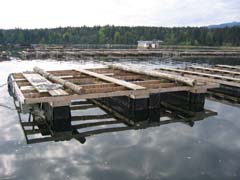
- While the oysters are on the farm they are subjected to frequent testing, some for research purposes (cadmium) and some to determine when various other organisms are setting. E.g., they watch very carefully for barnacle larvae and dip the oysters in a high saline solution immediately when they see larvae under the microscope (if you can see them with the naked eye you are too late).
- Finally, when the oysters are ready for market, they are transported to the upland processing facility where they go through a computerized sorting process. Keith is just beginning to use this equipment which he developed to the tune of $100,000, building on equipment used for sorting other fish. (Similar equipment is being used in Australia, and it is currently priced at approximately $55,000, not including shipping.)
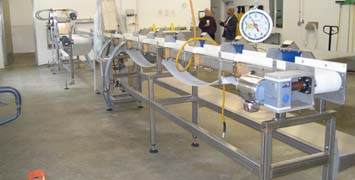
- Keith has some very special oysters he takes through a process of tumbling every month that assures deep cups, hard shells, no barnacles, etc. He charges significantly more for these perfect oysters, and he can sell them when nothing else is selling. He does suffer a 70% mortality on these but says that is not significant, given that he has his own flupse and makes so much more on these oysters!
- Keith mentioned having had conversations with a guy named Dan Brown from Tasmania who had been instrumental in establishing a collective that sounds as if it is similar to our co-op. They have been hugely successful, have a variety of policies in place that have added to that success. I could not find him/them on the web….
We had a wonderfull learning expierence seeing how mariculture is being acomplished in British Columbia. Thanks to Brian, Tom and Keith for thier time giving us the grand tour.



